Used Toyota Prius+ (2012-2020) Review
Written by Andrew Brady

- 2012
- MPV
- Hybrid
Quick overview
Pros
- Flexible seating for seven people
- Easy to drive and to live with
- Comes loaded with standard equipment
Cons
- Expensive to buy new
- Based on the previous generation Toyota Prius
- No longer the eco star it once was
Overall verdict
"It’s getting increasingly difficult to recommend the Toyota Prius+. The modern breed of electric cars and plug-in hybrid vehicles, while expensive, offer significant efficiency gains wrapped in a more desirable package. However, if you’re after a seven-seat MPV, the Toyota Prius+ is your only option."
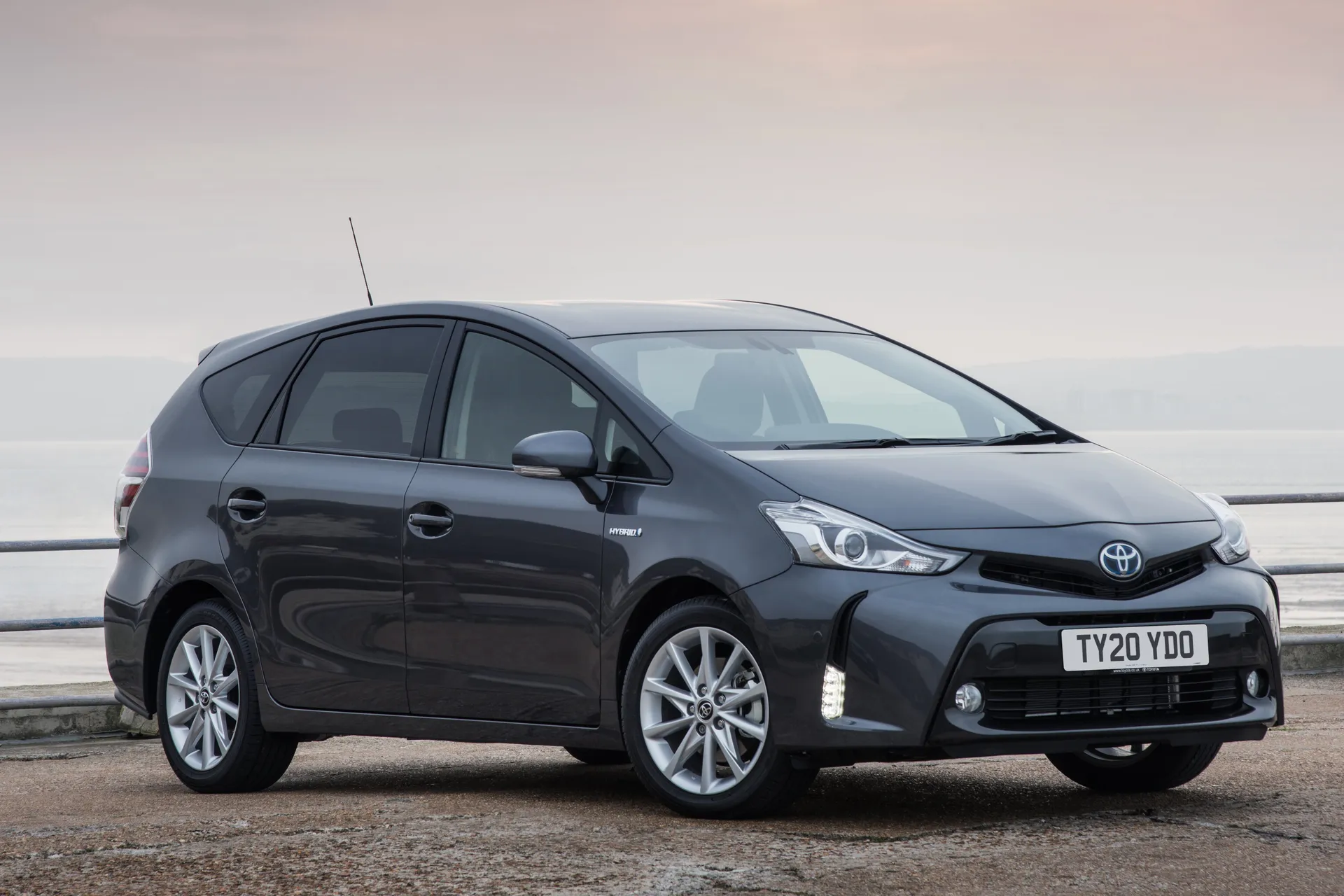
The Toyota Prius+ is the world’s first – and so far, only – seven-seat full hybrid vehicle. Launched in 2012 and updated in 2015, it ploughs a lonely furrow, looking increasingly like a square peg in a round hole.
It’s based on the previous-generation Toyota Prius, which puts it at a disadvantage in the wake of the latest breed of electrified vehicles. Unless you really need the third row of seats, we’d suggest looking at the latest Toyota Prius for an efficient hybrid, or the excellent Toyota Corolla Touring Sports estate for practicality.
It’s not all bad news. Although you’re limited to just one engine, the 1.8-litre petrol-electric hybrid is smooth and efficient, offering the ability to cover around a mile on electric power only. This is a car designed for urban driving and the occasional trip beyond the city limits. If you spend most of your time on the motorway, a diesel or an efficient petrol engine would be more suitable.
The cabin is showing its age, with dashboard architecture that’s based on the old Prius. Everything is mounted on the centre console, which is surrounded by a sea of grey plastic. On the plus side, although the materials used are nothing to get excited about, everything feels robust and built to last. This is a Toyota after all...
A good level of space in the front is matched by similar levels of roominess in the second row. Things are less positive in the third row, where the seats are best reserved for children or occasional use. On the plus side, Toyota’s ‘Easy Flat 7’ system offers a flexible seating arrangement, with a completely flat floor when the second and third rows of seats are folded away.
There are also plenty of storage bins and pockets, including a pair of gloveboxes, plus a central storage bin that can be accessed from both the front and rear seats. Unfortunately, space in the boot is limited when all seven seats are in place, but this is a problem affecting all seven-seat MPVs.
We’d say that the Toyota Prius+ drives like you’d expect a seven-seat MPV to drive, but it’s much better than that. It corners well, the steering is direct and ride quality is excellent, especially for a car weighed down by a battery pack.
Unfortunately, the 1.8-litre engine is no firecracker, while the CVT automatic transmission does its best to get in the way of enthusiastic driving. Although three driving modes are available, we’d recommend sticking it in ‘Normal’ and letting the computers take the strain.
In many ways, it’s hard to mount a credible case for the Toyota Prius+. It’s too expensive, dull to look at, boasts a cabin that lacks flair or imagination, and it won’t be particularly economical if you spend most of your time out of the city.
However, it’s your only choice if you’re after a seven-seat hybrid MPV. It’s also backed by a comprehensive warranty and Toyota’s excellent reputation for reliability. Maybe it’s not so bad after all.
Looking for a used car for sale? We've got 100s of Toyota Approved Used Cars for Sale for you to choose from, including a wide range of Toyota Prius+ models for sale.
Is the Toyota Prius+ right for you?
Toyota offers a range of increasingly desirable and compelling vehicles. As a result, the Prius+ is starting to look like an also-ran, struggling to keep pace with the bright young things at the front of the pack.
There are many factors working against the Prius+. It’s an MPV in the era of the SUV, it’s based on the previous generation Toyota Prius and it’s expensive to buy. Since the switch from NEDC to WLTP fuel economy testing, it’s also lost some of its eco car lustre.
On the, ahem, plus side, it offers space for seven, comes loaded with a generous level of standard equipment, and is an easy car to live with. You also get a sense that it’s built to last, which will come in handy if the Prius+ is to be used as an Uber workhorse.
What's the best Toyota Prius+ model/engine to choose?
The Toyota Prius+ is powered by a 1.8-litre petrol-electric hybrid engine, which is the same as you’ll find in the Lexus CT 200h. That’s it – you’re limited to one engine. Take it or leave it.
It’s fine, but nothing more. You’re constantly aware the powertrain is doing its best to maximise efficiency at all times, which can make rapid progress a frustrating experience. Not that this matters – maximum efficiency is one of this car’s best selling points.
There are two trim levels, with the entry-level Prius+ packing the basics required for a successful mum or dad taxi operation, including Toyota’s excellent Safety Sense driver assistance pack.
Upgrading to the next trim level adds the likes of heated seats, an improved infotainment system with navigation, park assist and rear sunshades. Toyota calls this model ‘a treat, inside or out’. If this is a treat, we’d rather take our chances with a trick…
What other cars are similar to the Toyota Prius+?
Toyota launched the Prius+ under the banner of the ‘world’s first seven-seat full hybrid vehicle’. Eight years on, it’s hardly overloaded with direct rivals. The truth is, if you’re after a hybrid, you’ll need to sacrifice a couple of seats. If you’re after an MPV, you’ll have to ditch the hybrid powertrain. The main competitor is probably the BMW 225xe Active Tourer - which is a PHEV but not a seven seater.
The seven-seat Lexus RX L 450h SUV is significantly more expensive than the Prius+, so you’re left with the crop of conventional MPVs. The Citroen Grand C4 SpaceTourer and Renault Grand Scenic both offer a terrific blend of style, practicality and fuel economy. If you want sensible, look at a Volkswagen Touran or indeed, Toyota's own Toyota Verso. If you want a hybrid, the Kia Niro is an excellent choice.
Comfort and design
"The dashboard layout will be familiar to anyone with experience of the Toyota Prius, with the controls and displays mounted on the centre console. It’s based on the old model, so is beginning to show its age, lacking the drama and interest of the latest Prius."
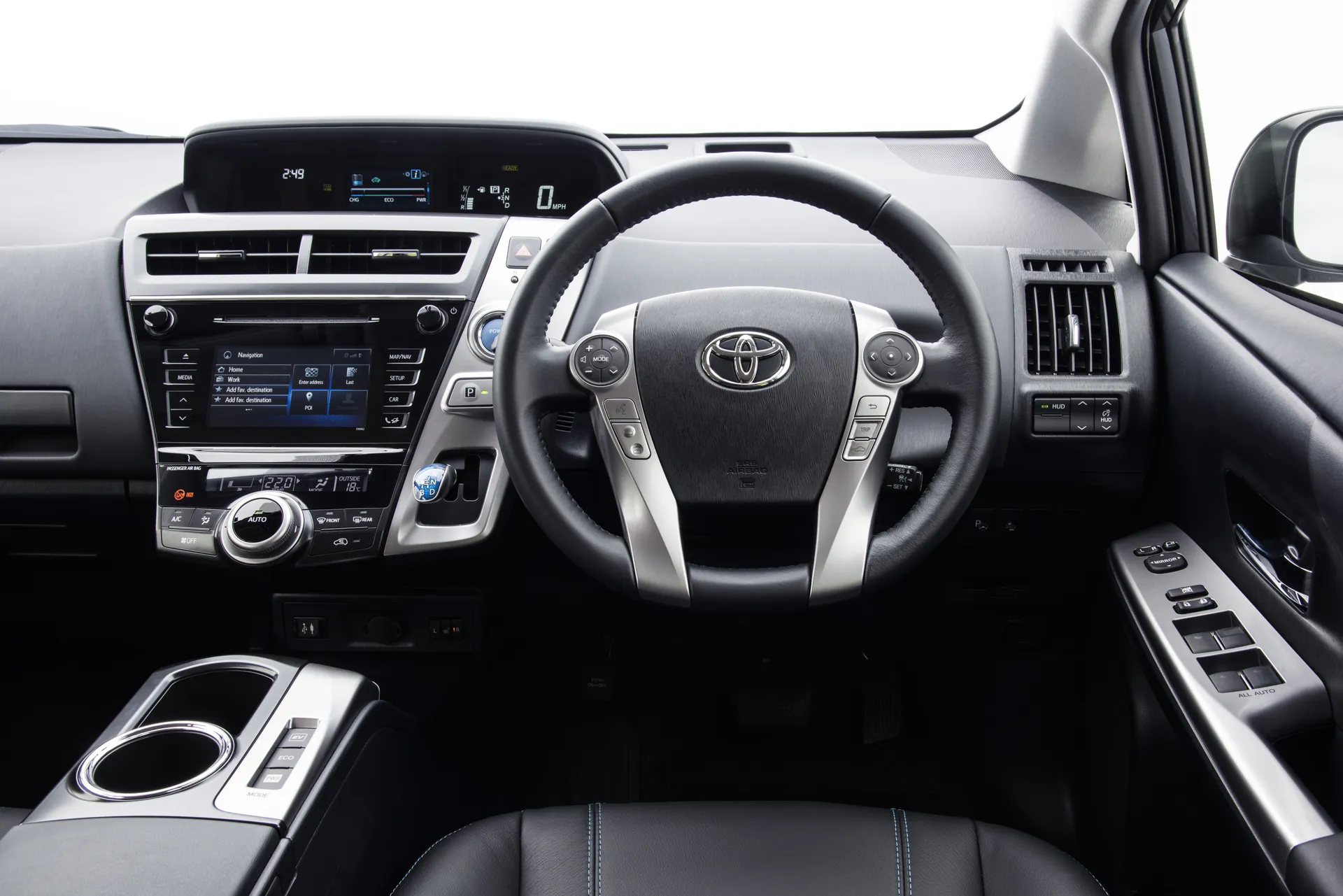
The instrument binnacle is mounted on the top of the dashboard and shows the speedometer and hybrid system indicator. It feels odd at first, but you’ll get used to it after a few miles. It’s actually quite relaxing to use on a long journey.
Other Prius hallmarks include the small shift lever mounted alongside the steering wheel, a large centre armrest, a start button and a cupholder that looks like it was based on the size of the largest American takeaway soft drink.
The driving position is excellent, aided by standard-fit electric lumbar support for the driver’s seat and that massive centre armrest. All-round visibility is similarly good, although the view out of the back window is restricted if the rear seats are occupied.
Although the dashboard lacks flair, changes introduced in 2015 serve to make Prius+ ownership a more pleasurable experience. Highlights include a dark silver metallic finish for the switchgear and a chrome effect for the door handles. Toyota also introduced a 4.2-inch TFT display atop the dashboard, along with chrome-trimmed air vents.
Quality and finish
Quality is excellent, especially when you take into account the fact that the Prius+ has been on sale for eight years. You need to look beyond the cheap looking dashboard and absence of soft-touch materials, because the cabin has been built to last. Everything feels robust and hard-wearing, albeit without the premium feel of many other cars at this price point.
All versions get a leather steering wheel, automatic air conditioning, front and rear electric windows and cruise control. Upgrading to the Excel model adds heated front seats, privacy glass, rear sunshades and synthetic leather seat bolsters. However, the fake leather feels cheap to touch and isn’t a huge improvement over the standard fabric seats.
Our experience of pre-owned examples of the Toyota Prius+ suggests that you’re unlikely to hear any annoying squeaks or rattles in the cabin, even after a lifetime of hard use and abuse. This car has been built to withstand attacks from unforgiving taxi passengers and boisterous children.
Infotainment
All versions of the Toyota Prius+ come with a 6.1-inch Toyota Touch 2 touchscreen infotainment screen. It boasts the features you’d expect, including DAB digital radio, Bluetooth, a reversing camera, car data and telephone info. The fact that it also features a CD player highlights how long the Prius+ has been on the market.
The Excel trim level features the upgraded Toyota Touch 2 with Go, which adds navigation, real-time traffic information and a range of connected services. Touch 2 with Go is optional on the Icon grade.
In both cases, the infotainment system feels a generation behind rivals and doesn’t offer the option of Apple CarPlay and Android Auto. The 6.1-inch screen is also too small, especially when viewed in the context of the system found in the Renault Grand Scenic.
Earlier versions of the Prius+ could be equipped with an Entertainment Pack. There were five versions of this, including one with twin docks and a twin DVD system – standard on the Excel Plus.
The basic version featured twin powered docks and a single iPad holder, while the next step up added a second iPad holder. The mid-grade option had twin docks and a single DVD player, while a fourth option included twin docks with a single iPad holder and a single DVD player.
Space and practicality
The Toyota Prius+ offers seating for seven, but the cabin isn’t as spacious as some rival MPVs. There’s plenty of headroom for people in the front, while three adults can sit comfortably in the second row. Unfortunately, the Prius+ suffers from the same problem as many MPVs - space is limited in the third row. The seats are fine for children, but adults won’t enjoy sitting there for any length of time.
Fortunately, it is possible to slide the middle row forward, but this simply reduces the amount of legroom for passengers sitting there. All three middle seats fold individually, with the centre seat designed to act as an armrest when not in use.
With the third row of seats folded down, the Prius+ offers a generous 768 litres of space. There’s a relatively high lip to get over, while the wheelarches eat into the available space, but thanks to Toyota’s Easy Flat 7 system, you’re presented with a flat floor when the seats aren’t in use. In two-seat mode, the Prius+ offers a van-rivalling 1731 litres.
With all seven seats in use, the luggage capacity shrinks to 232 litres – a figure more commonly associated with small hatchbacks and city cars. An optional luggage box offers an additional 410 litres of capacity and is designed to fit the Toyota roof bars.
Up front, you’ll find a pair of gloveboxes, the lower of which offers 8.5 litres of space, while the upper glovebox provides an extra 4.5 litres. The centre console storage box can be accessed from the front and rear seats. There are also large door pockets in the front and rear, plus a total of five cupholders distributed between the three rows of seats.
There are seat-back pockets for people in the second row, along with an underfloor storage compartment in the boot. Given the relatively compact dimensions of the Toyota Prius+, along with its petrol-electric hybrid system, the amount of boot and cabin space on offer is very impressive.
Handling and ride quality
"'Fall in love with driving again,' proclaims Toyota in the brochure for the Prius+. Honestly, you’ve got more chance of falling in love with driving again by taking the bus. A less memorable driving experience is hard to find.
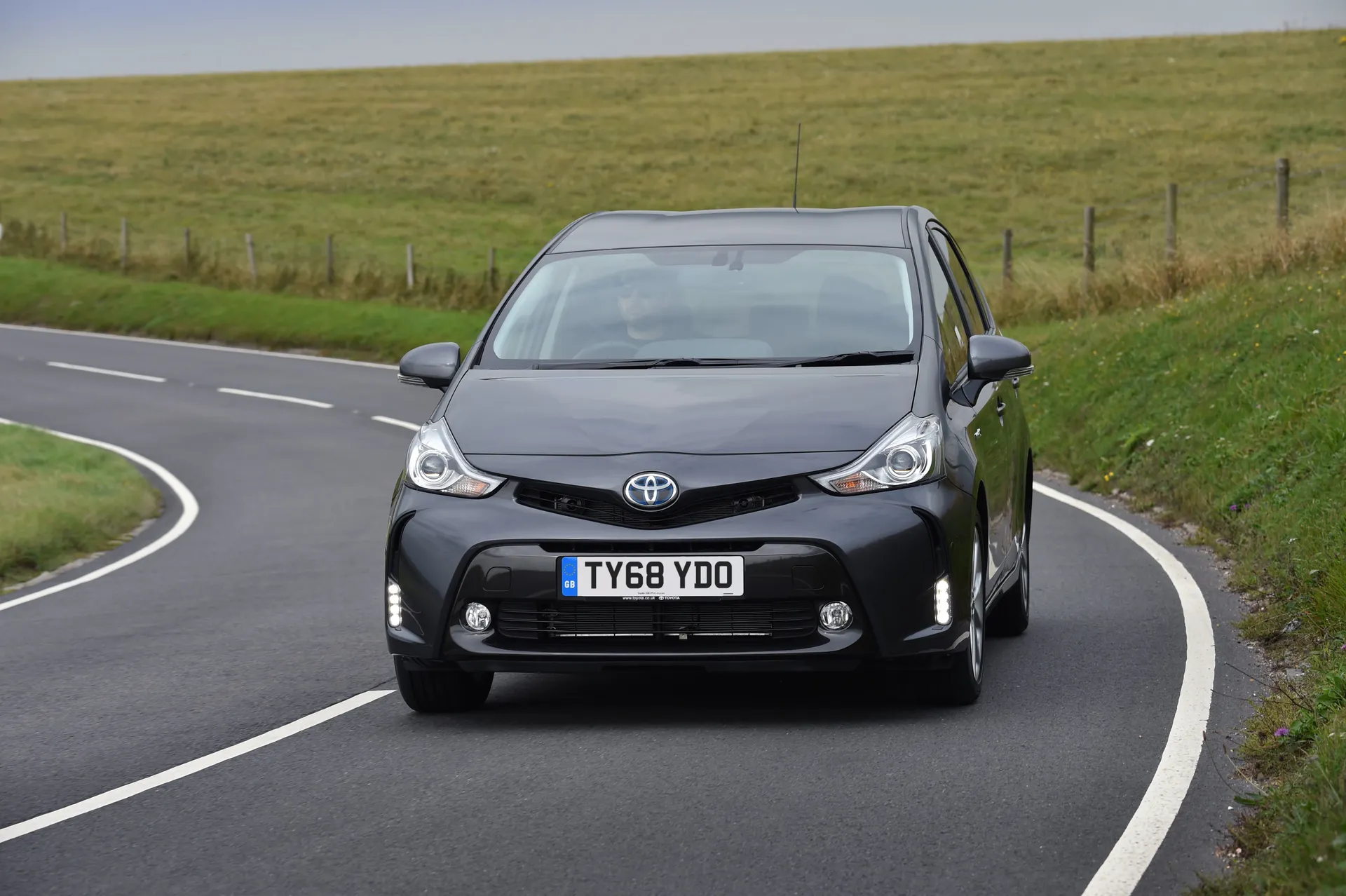
Not that this matters, because we doubt anyone will ever buy a Prius+ to go chasing sports cars and hot hatchbacks along a country road. Having said that, the Prius+ is far more pleasant to steer than you’d think. You’re unlikely to fall in love, but you won’t be sending hate mail either.
It corners quite tidily, with steering that’s direct if lacking in feedback. You’ll also experience less body-roll than in some rival MPVs, although the Prius+ will lean like a tower in Pisa if you take a bend too enthusiastically.
The Prius+ comes into its own in the city, where its good visibility, light steering and relaxed CVT transmission make it easy to park and manoeuvre. The ride quality is excellent, especially on the smaller 16-inch alloy wheels.
There are three on-demand driving modes: EV, Eco and Power. The latter is the one to use for making swift progress, as it increases throttle response by 25 percent to improve acceleration. It’s worth noting that the CVT transmission doesn’t react well to sudden inputs, with anything other than a relaxed right foot sending the system into a tailspin. You’ll also put a big dent in the fuel economy, which kind of defeats the object of the Prius+.
The car will start in EV mode, using just electricity to provide instant power and a smooth pull away. It will continue to run on electric until it reaches a speed of 31mph, at which point the petrol engine comes into play.
In Eco mode, the throttle response and air conditioning are reduced to improve efficiency. Toyota says fuel economy improves by 10%, but the knock-on effect is acceleration that feels like you’re pushing a wooden spoon through a barrel of treacle.
Engines and gearboxes
The Toyota Prius+ is powered by a 1.8-litre petrol engine and an electric motor. As a standard hybrid, it’s not possible to recharge the battery pack by plugging the car into the mains, with little more than a mile of electric range available at any one time.
Predictably, everything about the Prius+ has been configured to save fuel and the car will do its best to encourage you to drive with a featherlight right foot. The 0-62mph time of 11.3 seconds and top speed of 103mph hardly matter.
The 1.8-litre engine delivers smooth and linear acceleration, but feels strangled by the CVT transmission and hamstrung by the weight of the battery pack. Sticking the car in Power mode improves things a little, but the CVT transmission responds with lots of noise and little action.
Our advice would be to stick with Normal mode and allow the car to decide the best course of action.
Refinement and noise levels
For the most part, the Toyota Prius+ is remarkably refined. Adopt a relaxed and measured driving style to get the best from it, as the car doesn’t respond well to enthusiastic driving.
Because it starts in electric mode, you’ll enjoy the near-silent acceleration, which becomes rather addictive in the city. Toyota has a knack of making cars feel quiet and refined – and the Prius+ is no exception.
If you spend most of your time in urban traffic, you’ll swear blind that you’re in a car with a premium badge. It’s only when you reach the city limits that the Prius+ starts to show its limitations.
There’s a lot of wind and tyre noise on the motorway, while the CVT transmission becomes a frustrating companion when you’re trying to make swift progress on a fast road. The 1.8-litre engine also sounds laboured and intrusive at motorway speeds, and you’re left with an overriding sense that you’re not getting the best from the hybrid.
If you don’t require the benefit of seven seats, we’d recommend one of the new breed of Toyota hybrids. The Corolla, for example, is a class act and is available as a practical estate car. It’s cheaper to buy than the Prius+ and feels so much more refined on the road.
Safety equipment
The Toyota Prius+ hasn’t been tested by Euro NCAP, but the previous-generation Prius was put through its paces in 2009. It was awarded the maximum five-star safety rating, with some truly impressive individual scores.
These were 89% for adult occupant protection, 82% for child occupant protection, 68% for pedestrian safety, and 86% for safety assist systems. We have no reason to believe that the Prius+ wouldn’t achieve a similar set of results.
All models benefit from Toyota’s excellent Safety Sense system, which uses radar and camera sensors to detect and prevent collisions. Safety Sense includes road sign assist, pre-collision system with pedestrian detection, lane-departure alert, automatic high-beam and adaptive cruise control.
Standard features also include hill-start assist, a tyre pressure warning system, seven airbags, whiplash injury lessening seats and Isofix child car seat mounting points on the outer second row of seats. Rear parking sensors are an option.
The flagship version also features intelligent parking assist. It uses a rear-mounted camera and electric power steering to calculate the steering movements required to park. You define the limits of the space you want to park in, then the Toyota takes over. It’s a little disconcerting at first, but the system is a boon for nervous parkers. Unlike many rivals, the Toyota Prius+ comes with a temporary spare wheel, not an inflation kit.
How much does it cost to run?
"The Toyota Prius+ offers a claimed 47mpg to 48.7mpg on a combined cycle. These figures are based on the more reliable World Harmonised Light Vehicle Test Procedure (WLTP), which replaced the old New European Driving Cycle test (NEDC).
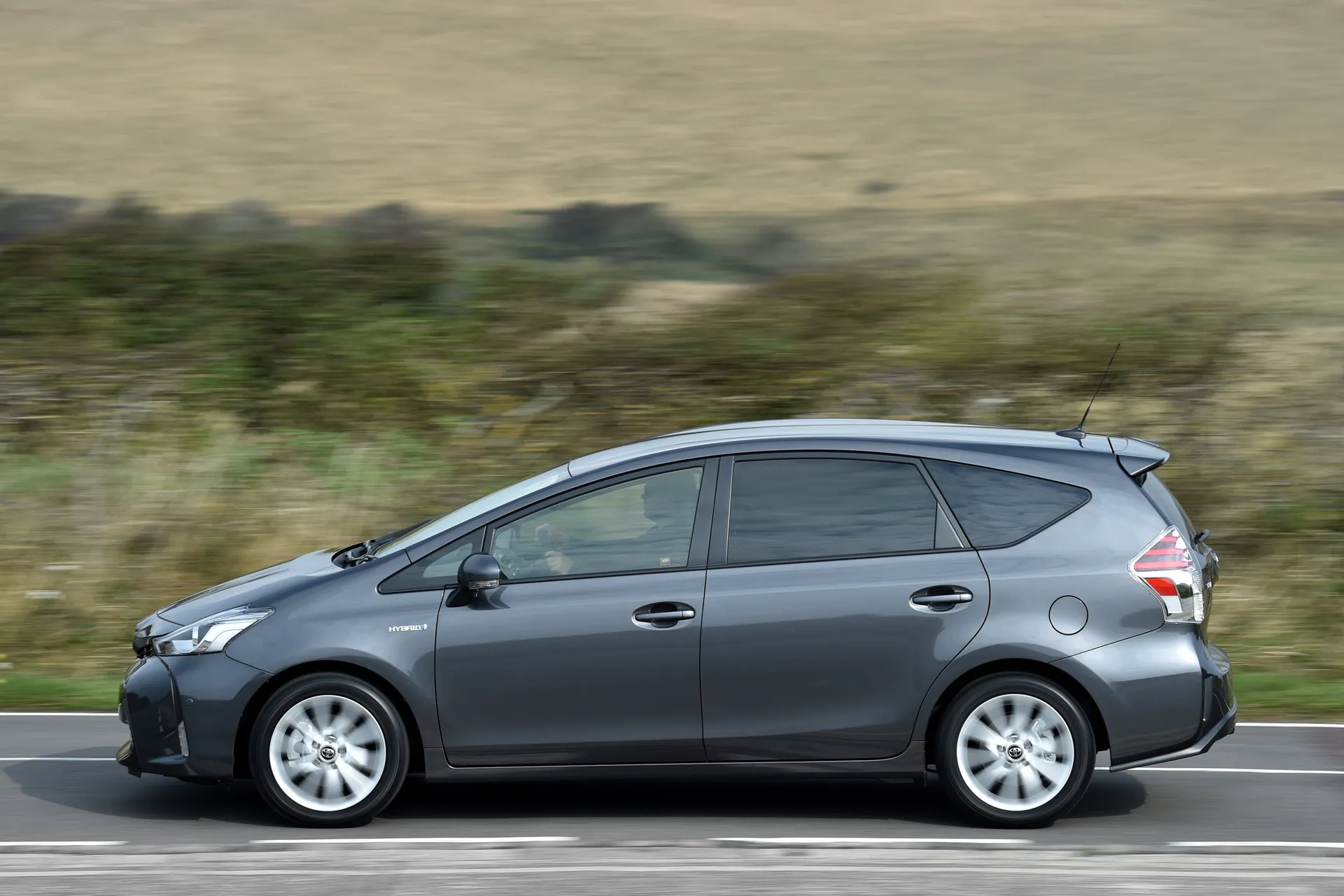
You should use these figures when considering the purchase of a Prius+, even if the quoted figures are higher. That’s because the old figures of 64.2mpg and 68.9mpg were recorded using the NEDC method.
Insurance groups and costs
The Toyota Prius+ Icon receives an insurance group rating of 11, while the Excel model is a group higher. These are low ratings for a seven-seat MPV.
For example, the rates for the Renault Grand Scenic range from 12 to 21, while the old Fiat 500L MPW slots into groups 8 to 17. Prius+ owners in London will find the cost of insurance is higher, especially if they use the car for taxi duties.
VED car tax
With CO2 emissions of 132g/km to 135g/km, the Toyota Prius+ includes a first-year ‘showroom tax’ of £205. This is included in the original purchase price of the car. From year two, this drops to £140. The rate is the same for cars registered on or after 1 April 2017 and before 31 March 2020.
The rates for earlier cars vary depending on whether the Prius+ was registered during the NEDC or WLTP test cycles. For example, some early examples are listed with CO2 emissions as low as 96/gkm. As a result, these cars are exempt from Vehicle Excise Duty (VED).
The Benefit in Kind (BiK) rate for current Toyota Prius+ models is 29% for the Icon and 30% for the Excel.
How much should you be paying for a Toyota Prius+?
"Toyota Prius+ prices start from around £9000. This price is based on UK-registered cars, but it is possible to find Japanese imports for a little less. Grey imports tend to be low-mileage cars, but will come without any UK service history."
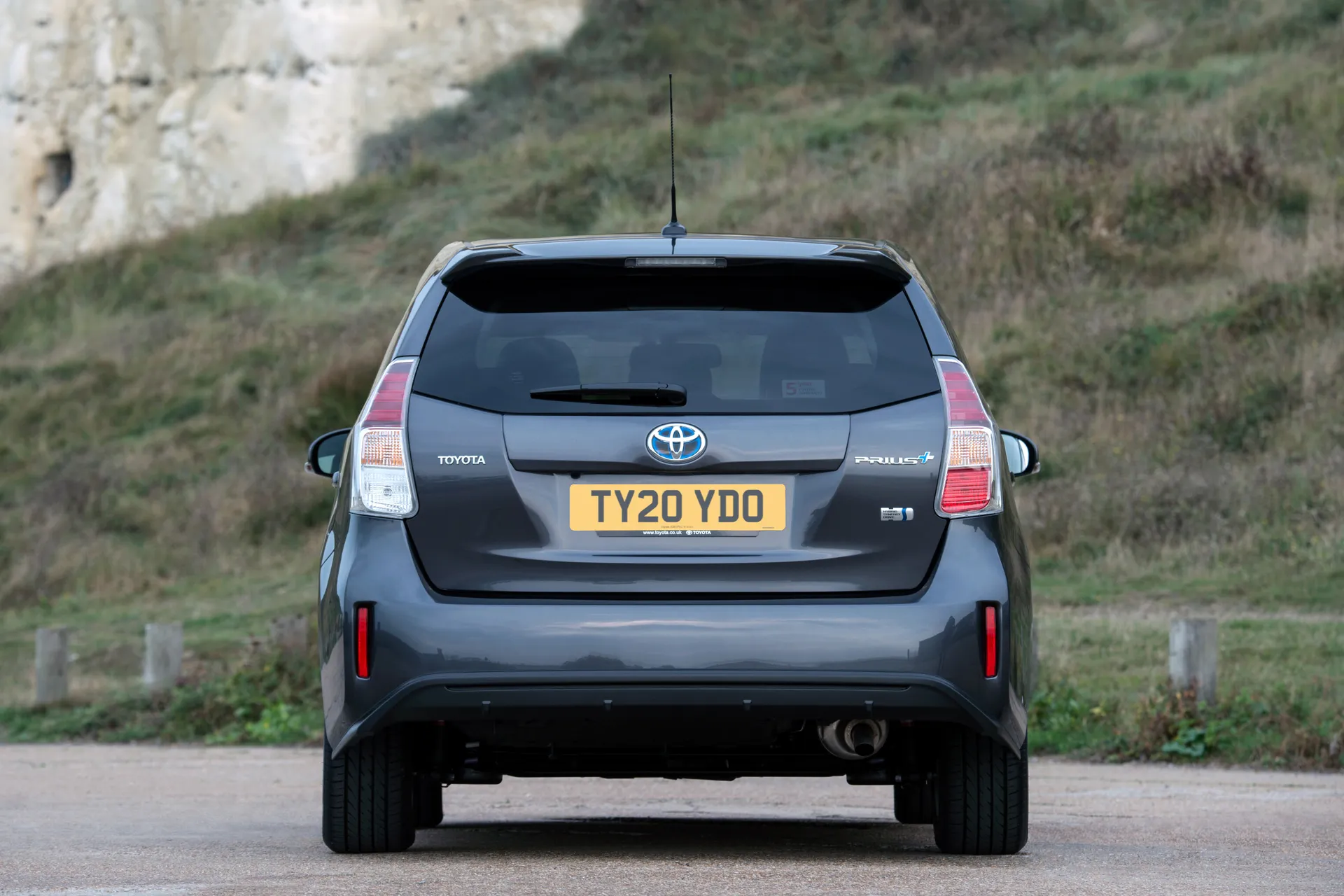
You’ll need to spend at least £13,500 on a post-facelift Prius+, but you’ll face competition from Uber drivers, especially in and around London. Crucially, the hybrid powertrain was upgraded in 2015 to comply with Euro6 emissions standards.
New and nearly-new cars tend to be available with a discount of up to £1000, but we’d recommend buying a 2019 example. Because the Toyota Prius+ suffers from relatively heavy depreciation, you’ll save around £10,000 by buying a car up to a year old. These cars will have the bulk of the original five-year warranty intact.
Trim levels and standard equipment
The Icon trim level features 16-inch alloy wheels, automatic wipers, automatic LED headlights, a reversing camera, keyless entry and start, Toyota Safety Sense, a six-inch Toyota Touch 2 infotainment system, automatic air conditioning, front and rear electric windows, a driver’s seat with electric lumbar support and a leather-trimmed steering wheel.
The Excel trim adds 17-inch alloy wheels, parking assist, rear privacy glass, synthetic leather seat trim, heated front seats, privacy glass, rear sunshades and Toyota Touch 2 with Go navigation.
We’d recommend buying a Prius+ registered after January 2015, as Toyota improved the styling, tweaked the interior and enhanced the specification. It also introduced a flagship Excel Plus trim level, which is worth finding on the used car market.
The Excel Plus trim level was discontinued in January 2018, when Toyota Safety Sense became standard across the Prius+ range.
Get our latest advice, news and offers
Keep me updated by email with the latest advice, news and offers from heycar.
By submitting you agree to our privacy policy


